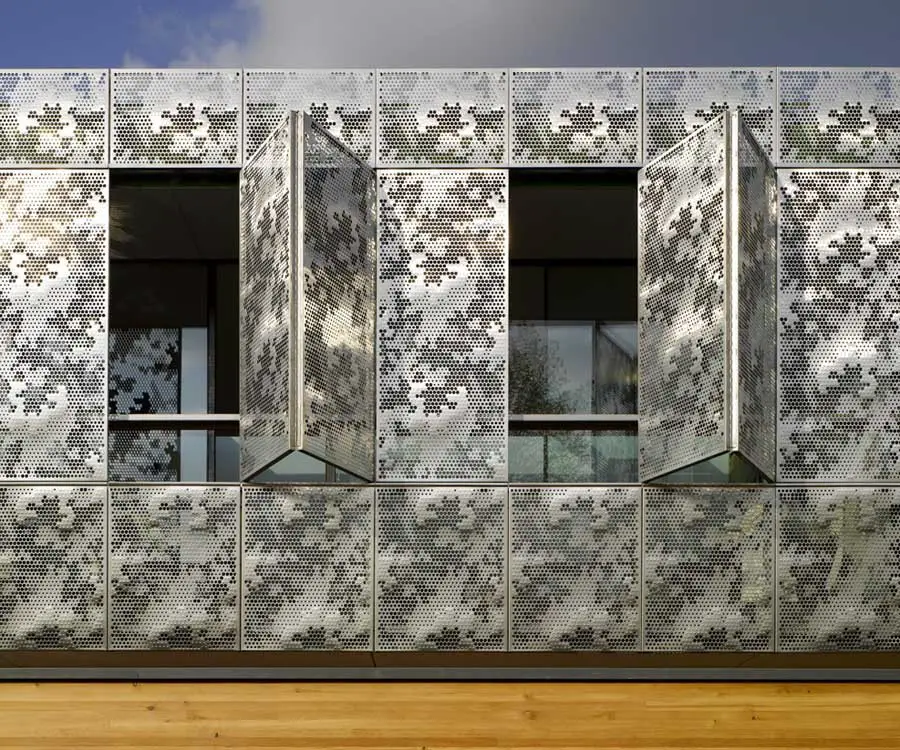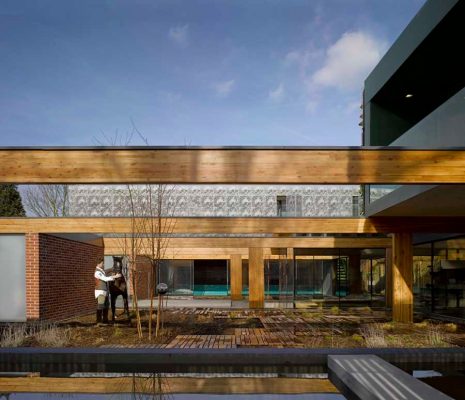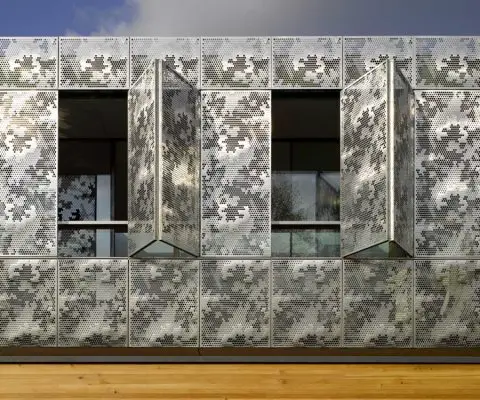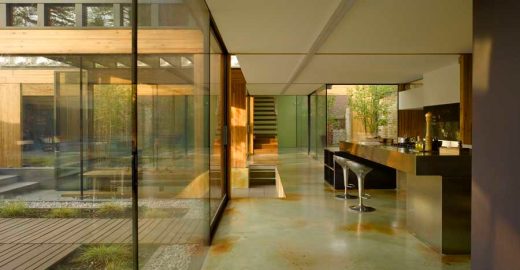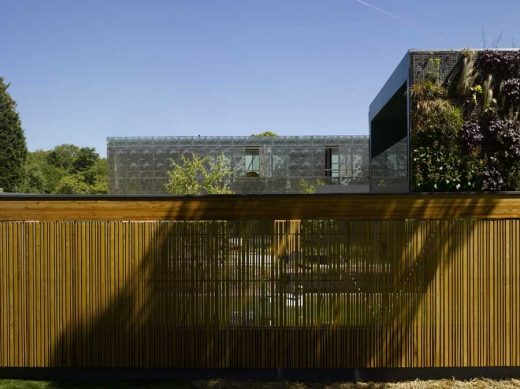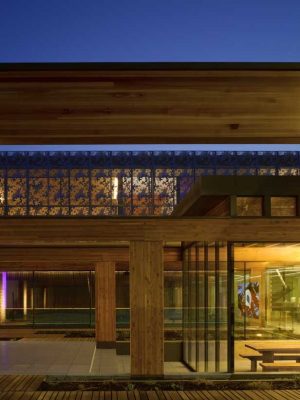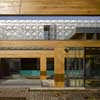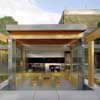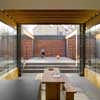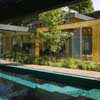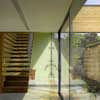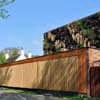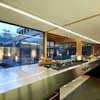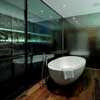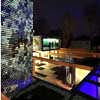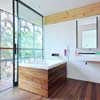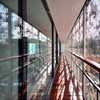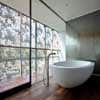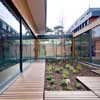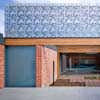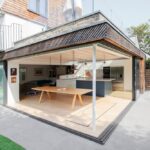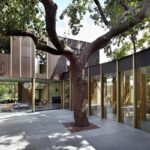Ladderstile House, Richmond Park Property, London Residential Building, English Design
Richmond Park Residential Development
Contemporary Property in London design by threefold architects / h2architecture
3 Nov 2009
Ladderstile House
Design: threefold architects / h2architecture
Ladderstile House designed by threefoldarchitects, and built by David and Anjana Devoy working with h2architecture on the interior design, landscaping and external screen and shutter details.
Richmond Park Residential Development design:
Developed as a luxury sustainable family home and currently for sale, Ladderstile House directly borders Richmond Park adjacent to Ladderstile Gate. Those interested in these homes can find a letting agent in London.
The land is the last remaining pocket of a once larger site associated with the original Ladderstile House, and retains an historic right to ‘ride out’ across the park, holding a key to a private gate associated only with this house. Stables have been incorporated into the new house in order that this may be continued.
Photos: Nick Kane
The design seeks to create a contemporary courtyard home, the spaces are arranged on the site to exploit natural light throughout day. The local Authority required the massing of the building to partly reflect that of the house, which previously occupied the site. The plan sets up a central landscaped courtyard with a series of satellite courtyards spread around the site, to create a diverse range of connections to different external rooms, and views through and in between the buildings, into spaces beyond, through glazing, the perforated steel and the timber screens.
The site is divided east/west by a series of large exposed glulam beams spanning the whole site at first floor level. This grid establishes physical and implied divisions across the site within the internal and external spaces beneath them.
The main living spaces run along the eastern border of the site beneath the beams, glazed entirely along the façade facing the central courtyard. Along the western side of the site, but set away from the boundary wall is the more private eastern wing containing guest bedrooms, bathroom, tack room and stables and linked to the southern boundary of the site by the carport and main entrance.
The bedrooms open onto a smaller external spaces, leading to a corner courtyard. The volumes of the western wing project in and out of the central courtyard, further dividing it into a series of connected external rooms.
The internal spaces are solid on their eastern elevation clad in brick matching the original building on the site, and glazed on the north and south where they project under the beams. These two main wings of the house are linked by the indoor swimming pool connecting them along the northern boundary, which has a series of large sliding doors opening the pool onto the courtyard.
The use of glulam for the structural beams and the solid timber superstructure that form the structural walls of the house both at ground and first floor have enabled the creation of very large spans and cantilevers which give the house its structural dynamism. Additionally this offsite method of construction leads to rapid erection of the superstructure on site. The ground floor volumes all have green roofs with hydroponic vertical gardens cladding the living room.
The energy for the heating, and hot water, is provided by geothermal boreholes. Heat exchangers utilise the constant temperature from the ground to provide all the energy required. Coupled with the high levels of insulation throughout the house this system has virtually no running cost dramatically reducing the carbon footprint and making this a truly sustainable house.
Nick Kane photographer : www.nickkane.co.uk
The house owner/developer worked with H2architecture to develop and complete the interior design, the detail of the timber front screen and the detail and final pattern of perforations to the stainless steel shutters.
The main block over the swimming pool faces south, containing two bedroom suites. It is conceived as a single volume sitting on the beams clad entirely with a veil of stainless steel panels perforated with an abstracted foliage design. Along the south façade these panels double as shutters screening a full length balcony to the master and second bedrooms, providing privacy and shade, which can be opened to allow unbroken sunlight in.
The bedroom suites are linked to the ground floor living spaces in the eastern wing by a cantilevered timber stair within a dramatic top lit double height space. The master bedroom is also connected to the western bedroom wing by a private back stair.
The second block over the main entrance area is conceived as a ‘hide’ which faces west looking out over Richmond park, containing the main living room, which connects to the kitchen on the ground floor, by a staircase running down to the basement utility room and wine cellar. The Hide volume is skinned on both sides by a hydroponic garden, visible from the street.
Ladderstile House – Energy Performance
The energy performance and sustainability of this scheme has always been a key aspect of the design approach, and is fundamental to both the aesthetics and the fabric of the building.
There was a dilapidated and grossly energy inefficient house located on the site, which was demolished for these reasons. It was uneconomical and unsustainable to renovate the existing property based on its state of disrepair.
During demolition as much of the reusable materials as possible were recycled, in the end this proved to be little other than the bricks, which have been incorporated into areas of the brick cladding along with the new hand thrown bricks made to match. Much of the remaining rubble was broken up on site and used as hardcore for the sub-base of the slabs. Anything else, which could be salvaged for reuse, was sold on as reclaimed materials.
The buildings’ superstructure is a prefabricated solid panel system, the walls, floors, roofs and structural beams are constructed from sustainably sourced cross laminated solid spruce. The exposed areas of timber, that is the main structural beams are from glulam larch treated with UV protectant, these are to be exposed and allowed to weather naturally.
The whole structure was prefabricated and erected on site in under 2 weeks. The system is significantly more sustainable and thermally efficient than conventional masonry construction and is faster to build and provides greater structural flexibility than conventional timber frame.
External walls are insulated outside the timber, and a rainscreen cladding is fixed with a ventilated cavity behind. The cladding varies between the recycled and new bricks at ground floor, and powder coated aluminium overlaid with a stainless steel filigree veil at first floor level. The 1st floor hide component is then clad additionally with a planted wall system developed specifically for the project.
The reason for the aluminium in this case was to satisfy Building Control, which required a maintenance free cladding layer behind the planting. This reason also applies to the protective layer behind the perforated stainless steel screens. It would have been our preference that both planting and the stainless steel were the rainscreen to the cladding build up in each case.
The roofs to all the ground floor volumes are a warm roof construction with tapered PIR insulation, and a Bauder Sedum roof build up. The sedum provides additional insulative properties, and a textured more aesthetically appealing covering seen from the first floor blocks, as you look out over the park. The roofs are give the impression of an elevated extension of the courtyard.
All rainwater is collected and stored below ground in a 10,000 litre tank, reused for irrigating the green walls, sedum roofs and landscaped courtyards. The reason it is not recycled for toilet flushing is because the sedum discolours the water too greatly, so it was a trade off between the planting or the recycling.
All the glazing, of which there is 320m2, provides the internal spaces with additional heating in winter through passive solar gain warm the high theral mass of the concrete floors. The units are from low-emmisivity glass, argon filled cavities, with a low U-Value, to reduce the overall heat loss.
The house is heated and cooled by an underfloor heating system contained in an insulated concrete screed at both ground and first floors. The energy for the heating, hot water, and for the swimming pool heating is provided by 800m of geothermal boreholes.
Heat exchangers located in the plant room utilize the constant temperature from the ground to provide all the heating required. In summer the process is reversed and the temperature of the ground is used to remove heat from the spaces through the screed. Coupled with the high levels of insulation throughout the house this system significantly reduces the cost of heating the home, but more importantly dramatically reduces the carbon footprint.
Ladderstile House – Building Information
Architect: THREEFOLD ARCHITECTS, London
Architect (landscape/interior design/front timber screen/pattern design steel screens): H2ARCHITECTURE, Kingston
Owner/Contractor: A&D DEVOY, London
Project Manager: BEN CAPEHORN, London
Structural Engineer (Superstructure): TALL ENGINEERS, London
Planting Design/Planted Cladding: THOMAS GODWIN
Geothermals Design/Installation: WDS ENVIRONMENTAL
Structural Frame Supplier/Contractor: EURBAN
Aluminium Cladding/Stainless Steel Screens: EUROCLAD
Glazing: FIRMAN GLASS
Roofing: K&B ROOFING
Richmond Park Residential Development images / information from threefoldarchitects
Location: Ladderstile Gate, Richmond Park, London, England, UK
Richmond Properties
Richmond Buildings
Barnes Brick, Barnes, London Borough of Richmond
Design: YARD Architects
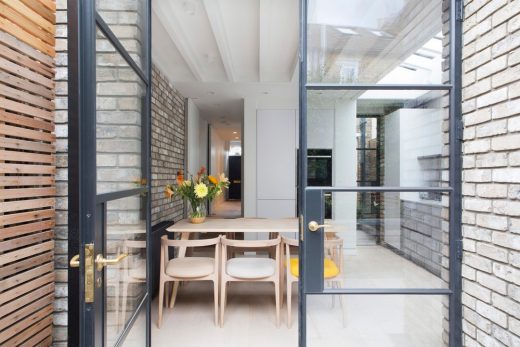
photograph © Agnese Sanvito
Barnes Brick
White Lodge House in London, Upper Richmond Road, SW15 6TL
Design: Studio Octopi architects
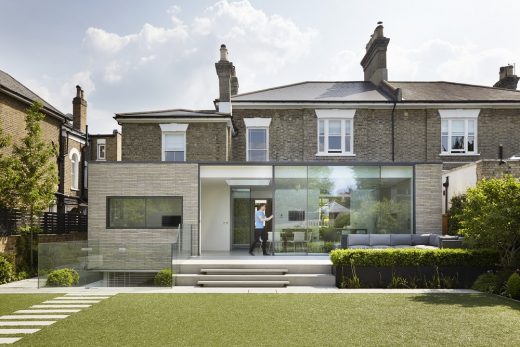
photograph : Jack Hobhouse
White Lodge House, Upper Richmond Road
Kingston Academy Regeneration
Design: Astudio
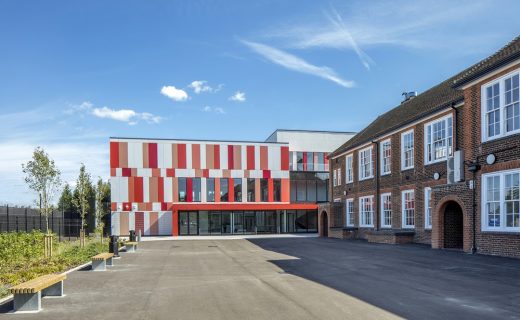
image from architect studio
Kingston Academy Regeneration, Richmond Road
London Buildings
Contemporary London Architecture
London Architecture Designs – chronological list
Architecture Tours in London by e-architect
Brexit Bunker
Design: RISE Design Studio
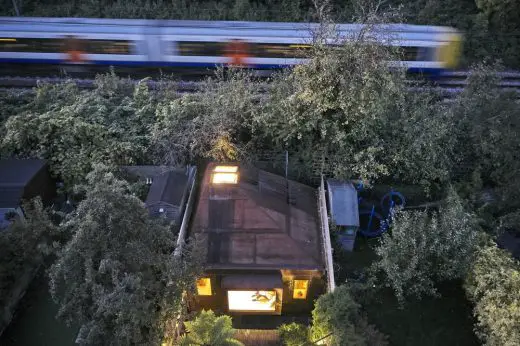
photo : Edmund Sumner
Brexit Bunker
Duke’s Avenue House, Chiswick
Architects: IBLA
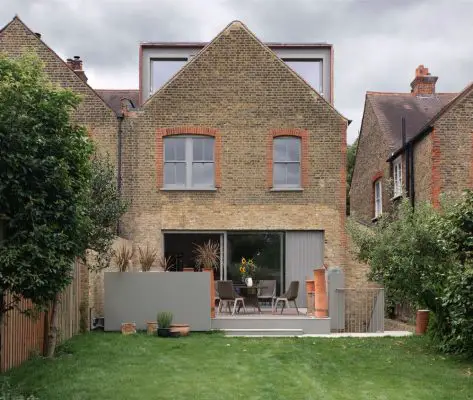
photo : Brotherton Lock
Contemporary House in London
Comments / photos for the Ladderstile House London – Richmond Park Property page welcome

